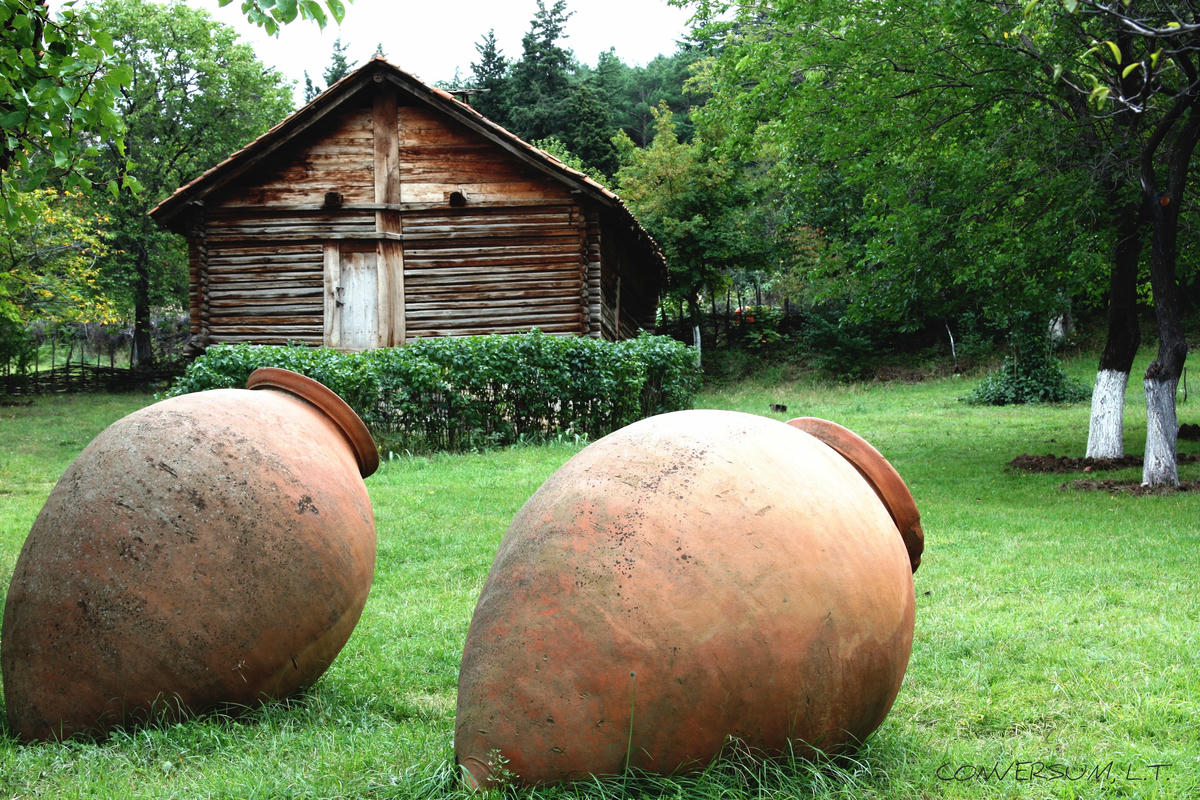Şarabın tarihi Ermenistan’da başlar


2010 yılında, yaklaşık 5 bin 500
yaşındaki dünyanın bilinen en eski deri ayakkabısı,
Ermenistan’ın Areni Köyü’nde bir mağarada bulunduğunda, bu
büyük keşfi yapan arkeologlar, aynı zamanda insanlık tarihinde
başka bir dönüm noktasını daha gün yüzüne çıkarmış
oldular. Yapılan kazılarda binlerce yıl öncesinden kalma bir üzüm
cenderesi, mayalama kapları, şarap mahzeni, kadehler ve kurumuş
şarap üzümleri bulundu. Yapılan hesaplar, şarap tarihinin
yaklaşık 6 bin 100 yıl önce dünyanın bilinen en eski
şaraphanesi olan Areni’deki bu mağarada başladığını ortaya
koyuyordu.
Bu keşif Amerikalı iki şarapsever bilim insanını harekete geçirdi. Amerika Doğal Tarih Müzesi’nden Ian Tattersall ve Rob DeSalle, ‘Şarabın Doğal Tarihi’ kitabıyla hem Ermenistan’daki mağaradan başlayarak şarabın tarihini yeniden yazıyor, hem de binlerce yıl önce kullanılan tekniklerin bugünkü yansımalarının peşinden gidiyor.
Ritüeller
İki bilim insanı Tattersall ve De Salle, “Şarap mayalandırmayı yaşayan bir kültür olarak düşünebilirsiniz. İnsanlar yerleşik düzene geçtiklerinde yaptıkları ilk şeylerden biri üzüm mayalandırmak oldu” diyor. Biz de bu yaşayan kültüre, şarabın Ermenistan’daki köklerine uzanıyoruz.
Deri ayakkabılı şarap sever kadim insanların kimliği gizemini korusa da, içki kültürlerinin, ölülerinin onurlandırmak için yaptıkları ritüellerden geldiği ortaya çıkıyor.
‘Areni-1’ isimli mağarada çalışan arkeolog Gregory Areshian, “Üzüm cenderesinin etrafında gömülü yirmi kadar cenaze belirledik. Bu mağaradaki şarap üretimi de bu ritüelle ilgili” diyor ve ekliyor, “Mağara izbe bir yer olduğundan cenazeler için de uygun sanırım, fakat aynı zamanda şarap yapmak için de güzel bir yer. Ayrıca hemen yanı başınızda şarap var, böylece atalarınızı da mutlu edebilirsiniz.”
Mağaranın derinlikleri
Arkeologların çalışmaları yavaş bir şekilde devam ediyor, ulaştıkları son katmanlarda, Cilalı Taş Devri’yle Tunç Çağı arasında kalan yaklaşık 6 bin yıllık döneme ait daha önce bilmedikleri bir yaşamın izlerine rastlıyorlar. Öyle ki bu dönem Yakın Doğu’da yerleşik hayatın oturduğu, Areni-1 mağarasında yaşayanların, ölülerini, sahip oldukları diğer şeylerle beraber mağaranın derinliklerine gömdükleri bir dönem.
Yazarlar Tattersall ve DeSalle, “Mağaranın girişindeki aydınlık ve havadar kısmı geçip derine ilerlediğinizde, doğal ışıklandırma yerini, sol taraftaki derin çukura bağlanan cereyanlı uzun ara pasajı aydınlatan ışık huzmelerine bırakıyor” diyor.
Areni-1’deki bulguları önemli kılan, aksi takdirde kolayca çürüyüp yok olacak olan organik maddeleri muhafaza edecek türden serin ve kuru iç mekan… O dönemin günlük yaşamında kullanılan alet edevatı da barındıran Areni-1, kadim insanların bize bıraktığı tarihte bilinen ilk şaraphane.
DNA çalışmaları
Koca bir mayalama teknesi ve kendine has üzüm ezme düzeneğiyle Ermenistan’daki bu mağaranın önemi büyük, çünkü şarabın tarihini ortaya çıkarmaya çalışan bilim adamlarının ulaşabildikleri yegane izler çoğunlukla dolaylı oluyor, örneğin içinde şarap muhafaza edildiği düşünülen bir fıçıdaki kimyasal izler… Areni-1’in ise üzüm ezme katında pek çok kırık çömlek parçası bulunmuş. Parçaların üzerinde, karbon testlerinde yaşı 6 bin ile 6 bin 100 yaşında çıkan üzüm kalıntıları tespit edilmiş.
Yakın zamanda sonuçlanan DNA çalışmaları, üzümün de ilk olarak Güney Kafkasya’da ehlileştirildiğini ortaya koyuyor. Bağcılığın da 5 bin sene önce Mezopotamya, Ürdün ve Mısır’a gittiğine dair yeteri kadar arkeolojik kanıt var. Bağcılığınsa Areni-1’deki ilk şaraphaneden çok daha önce başladığını söyleyebiliriz.
Tattersall ve DeSalle, “Areni-1’deki şaraphanenin şaşırtıcı yanlarından biri de testi olarak da kullanılan, adeta bir şarap küpü ‘mezarlığında’ bulunmasıydı. Bu küpler aynı zamanda farklı yaşlardaki kişilerin kalıntılarını da barındırıyordu. Erkeklerin ölüleri yakılırken kadınlara ve çocuklara ait kalıntılar parçalara ayrılmış. Hayvan boynuzlarından yapılmış kadehlerde bulundu” diyor.
Areni-1’de çalışan şef arkeolog Boris Gasparyan’a göre şarap yapımıyla, ölü yakma-parçalama ve defin gibi ritüellerin yakın bir ilişkisi var. Yazarlar, “Eğer durum Gasparyan’ın söylediği gibiyse, Areni-1, antik çağların sonraki dönemlerinde sıkça görülen, cenaze ve diğer ayinlerde mayalanmış içki kullanma geleneğini de başlatmış olabilir” diyor.
Şarabın beşiğinden
Ermenistan ve Gürcistan’da hala 6 bin sene önce Areni-1 mağarasında kullanılan tekniklerle şarap yapılıyor. Üzümler, Ermenice ‘karas’, Gürcüce ‘kvervi’ adı verilen kil çömleklerde mayalanıyor.
Ermeistan’da bağcılığı en çok yapılan, ismini Areni Köyü’nden alan üzümler , İtalyalı Ermeni Zorik Gharibian’ın girişimiyle ‘Zorah Karasi Areni Noir’ adıyla şişeleniyor. Bir süre İtalya’da yaşadıktan sonra şarap endüstrisini canlandırmak için Ermenistan’a dönen Gharibian, bu binlerce yıllık ‘karas’ geleneğini kullanmaya gayret etmiş.
Ermenistan’ın komşusu Gürcistan’da da aynı yöntemle, ‘kvevri’ şaraplar üretiliyor. ‘Iago Bitarishvili Chinuri Qvevri 8’ ve ‘Khareba Saparevi’ adıyla işelenen şaraplarla üreticiler kadim geleneği yaşatmaya çalışıyor.
Levon Bağış: Kadim usullerle Antik Çağ şarapları
Areni-1 mağarasının bulunmasından önce bilinen en eski şaraphane Çin’de, şarapçılıkla ilgili en eski buluntu ise Zargos Dağları’ndaki ‘Hacı Firuz Tepesi’nde yer alıyordu. Hacı Firuz Tepesi’ndeki buluntular, eski insanların şarabı testilerde sakladığını işaret ediyordu. Kutsal Kitap’a göre de şarabın üretildiği yer ilk Anadolu... Tufandan sonra ilk olarak Ararat Dağ’ına ayak basan Nuh Peygamber’in ilk yaptığı iş, bağ dikip şarap yapmakmış. Üstelik Nuh’un pek kararında içtiği de söylenemez, kitaba göre içip sarhoş olmuşluğu da var. Tevrat’ta bu olay “Gemi yedinci ayda, ayın on yedinci gününde Ararat Dağı’nın üzerine oturdu… Ve Nuh çifti olmaya başladı ve bir bağ dikti ve şaraptan içip sarhoş oldu” diye anlatılır. Bu efsaneyi tarihin büyük şarap sevdalılarından Benjamin Franklin kendince şöyle yorumlar: "Nuh'tan önce tek içeceği su olan insan, hakikate bir türlü ulaşamıyordu. Dolayısıyla korkunç derecede zalimleşti ve içmeyi onca sevdiği su tarafından, hak ettiği gibi yok edildi. Tüm çağdaşlarının bu sevimsiz içecekle dağılıp gidişini gören iyi adam, Nuh, suya karşı bir hoşnutsuzluk geliştirdi. Onun susuzluğunu gidermek isteyen Tanrı, asmayı yarattı ve Nuh'a şarap yapma sanatını gösterdi. Bu sıvının yardımıyla o günbegün yeni hakikatleri gün yüzüne çıkardı."
Tıpkı, Doğu Anadolu ve Gürcistan gibi şarabın anavatanı olan Ermenistan, nüfusun azlığı ve hemen hemen hiç yurtdışına şarap ihraç edemeyişi nedeniyle toplamda sadece 5 milyon litreye yakın şarap üretiyor. Ürettikleri şaraplar genellikle eski usul, demir perde ülkelerine özgü yarı tatlı şaraplar… Ama bu tarz eski usul şaraplar dışında, Voske Hat, Hınduğnı, Kangun ve Areni gibi pek çok yerel üzümden ve uluslararası tanınmış çeşitli üzümlerden iyi şaraplarda yavaş yavaş üretilmeye başladı.
Antik çağ şarapçılığında üretim ve saklamak için en sık kullanılan kaplar, topraktan yapılma büyük küpler. Bu küpler zamanla yerini şarabın tadını daha olumlu etkilediği düşünülen ve bugün de kullanılmakta olan genelde meşe ağacından üretilmiş fıçılara bıraktı. Dünya üzerinde şarabın üretildiği ilk yer olan Transkafkasya yani Ermenistan, Gürcistan ve Doğu Anadolu’yu kapsayan bölge dışında bu kadim usullerle üretim yapan pek bir üretici yok. Kapadokya’da son yıllarda Gürcistan’dan öğrendiği teknikler ile üretim yapan Gelveri Şarapları da ülkemizde bu şekilde üretim yapan tek üretici…
Teknik olarak bakılınca küplerin hava geçirgenliği şarapların gövdesinin yumuşayıp daha rahat içimli şaraplar üretilmesine izin veriyor, tıpkı meşe fıçılar gibi, fakat fıçılar kadar kontrollü olmayan bu hava geçirgenliği şarapların kolay okside olmasına yani bozukluğa benzer tatlar ve kokular ortaya çıkmasına neden oluyor. Ayrıca toprak kapların şaraba geçirdiği topraksı ve yoğun kokular pek çok şarapsever için alışagelmiş hatta kabul edilebilir tatlar değil.
Her ne kadar, artık unutulmuş olsa da bu kaplardan esinlenilen ve çağdaş şarapçılıkta kullanılan topraktan yapılma yeni nesil yumurta formunda şarap tankları da yavaş yavaş şarapçılık aleminde popüler olma eğiliminde.
Hem tarihsel hem de coğrafi özellikleri nedeni ile şarabın anavatanı olarak kabul edilen bu bölgeler, sahip oldukları binin üzerinde üzüm cinsi ve kültürel mirası sayesinde önümüzdeki yıllarda gidererek popülerleşecek şaraplar üretme yolunda emin adımlarla ilerliyor.



